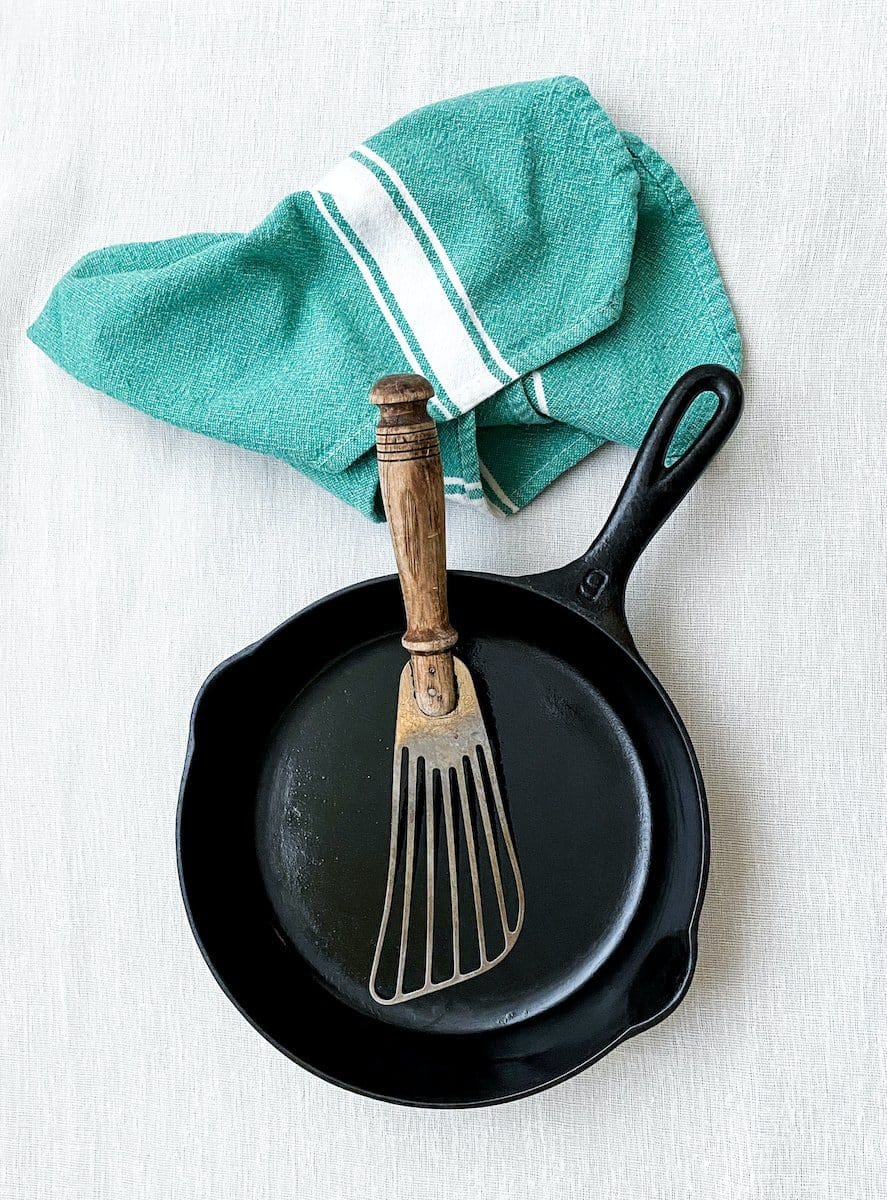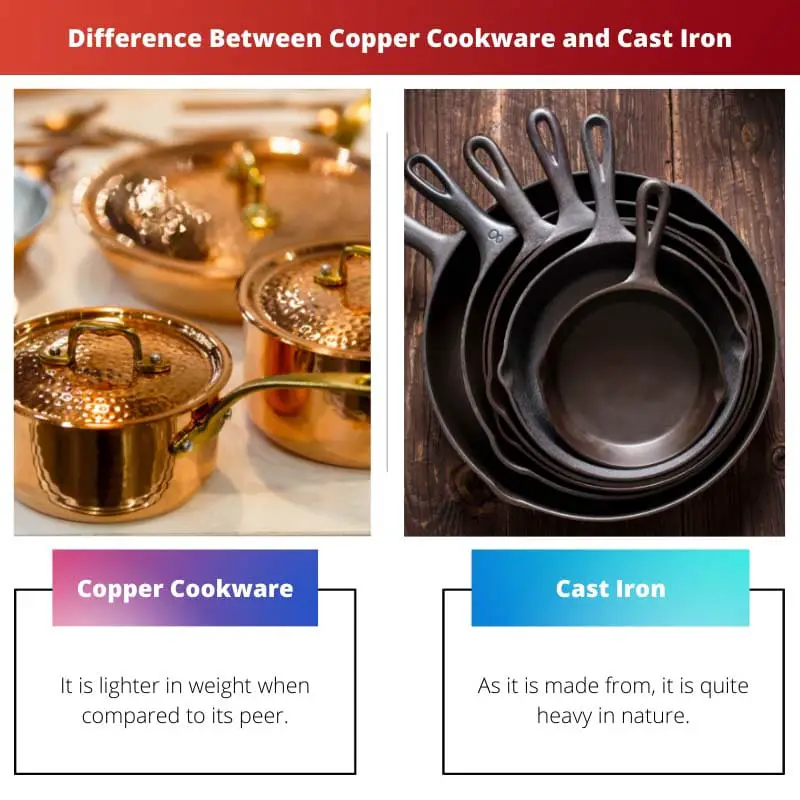Cooking is a universal process that takes place regardless of country, financial standing, or culture. It’s been practised from the beginning of time. Previously, it was simply because most veggies were consumed partially cooked or uncooked.
However, new cuisines, soups, and other items have been observed in recent years. Almost no one eats half-cooked or uncooked vegetables.
Key Takeaways
- Copper cookware is made of copper, an excellent heat conductor, and is used by professional chefs to cook delicate sauces or foods. Cast iron cookware is made of iron and is known for its durability and heat retention.
- Copper cookware is more expensive and requires special care to prevent discoloration or damage, while cast iron is affordable and low-maintenance. Copper cookware is also lighter and easier to manoeuvre than cast iron.
- Copper cookware can react with certain foods, while cast iron can add iron to cooked foods. Copper cookware is best for cooking delicate foods that require precise temperature control, while cast iron is great for searing, frying, and making stews.
Copper Cookware vs Cast Iron
The difference between Copper Cookware and Cast Iron is the former requires much more maintenance, whereas Cast Iron that hasn’t been cleaned for a long time can be used for campfires. Cast Iron skillets are quite durable when compared to other cooking ware.

Copper cookware refers to copper-based kitchen appliances. As a result, it possesses all of the metal’s qualities. Due to its great heat conduction power, it is recommended for quick frying. They can be used for a long time and are also oven safe.
They also have certain drawbacks, such as requiring maintenance, which can be used with acidic foods.
A cast iron skillet is composed of iron if it is aged or enamelled. Iron is robust and long-lasting, and it can withstand harsh temperatures. Cast iron that hasn’t been cleaned could be used for grilling and campfires. Bonfires must be avoided while using epoxy iron.
Both cook delicious meals, excluding the heat source.
Comparison Table
| Parameters of Comparison | Cooper Cookware | Cast Iron |
|---|---|---|
| Based on weight | It is lighter in weight when compared to its peer. | As it is made from, it is quite heavy in nature. |
| Cost | It is slightly expensive as copper is pricey in nature. | It’s not that pricey! Particularly for the pre-seasoned/bare metal variants. |
| Heating Capability | Copper Cookware can handle the heat in a better manner and lead to a uniform distribution. | The grip will become extremely hot! Mitts or potholders should be used frequently. |
| Reactivity Nature | Reacts quickly to temperature variations, which is beneficial while sautéing. | Seasonings can’t handle highly acidic foods frequently without having to re-season. |
| Brittleness | At a certain stage, the tinned liner will have to be re-tinned. | On enameled variants, the porcelain is a touch fragile. Avoid striking it with metallic cutlery or the sink’s base. |
What is Copper Cookware?
According to Practical Foods’ professional cooks and gourmet blogger Daniel Gritzer, copper cookware is “the luxury supercar of the cookware industry.” Copper cookware, like a high-end sports car, is not cheap.
However, the high-cost results in great heat capacity, which has several advantages.
Copper warms up more quickly than stainless steel and aluminium, allowing users to quickly heat materials while saving time and energy and thus providing better efficiency.
The uniform heat distribution feature reduces inconsistent cooking and burnt/stuck-on food caused by uneven heating and trouble spots.
According to Serious Eats, it also responds rapidly to temperature changes, which is useful when preparing fish, crustaceans, sauces, caramel, and chocolates.
Copper cookware, like a high-end sports vehicle, requires a lot of upkeep. To begin, it is not dishwashing friendly. Thus all components must be washed by hand. Secondly, one must dry any components immediately after cleaning them to avoid spots or discolouration caused by water drips.
Finally, you must clean copper cookware regularly to prevent corrosion and retain its gorgeous gloss.
Copper toxicity occurs when copper combines chemically with acid and alkalinity (full fruits and veggies, legumes, nuts) substances, melts, and then parasites in whichever dish is being prepared, causing nausea, puking, and diarrhoea.
As a result, use copper cookware coated with a non-reactive material that hasn’t been damaged.

What is Cast Iron?
Cast iron cookware, whether weathered or enamelled, is made of iron. Iron can resist extreme temps and is tough and long-lasting. Cast iron that has not been polished can also be used on bonfires and in cooking. When utilizing enamel-coated iron, bonfires should be averted.
Both cook great food, except for the source of heat.
Liquified iron and steel pieces are mixed through iron casters to create the kitchenware parts. Following that, the melted mixture is then poured together into moulding sand. These abilities have been honed over centuries and are performed in a production plant.
They liberate the kitchenware by shattering the mold once it has cooled. The cookware is made of iron, and the producer adds additives to the mixture to enhance the atmospheric carbon, producing the ideal iron blend.
Cast iron cookware quickly established itself as a reliable piece of kitchen utensils in homes around the world. Even today, some individuals are perplexed about why cast iron things may be so costly.
The grade of the items used to produce the ferrous combination can be directly associated with the cost of a kitchenware component. With interest to the rendering method. Manufacturers that widespread goods with lower-quality materials will generate a lower-cost end product.

Main Differences Between Copper Cookware and Cast Iron
- Copper Cookware is lighter in weight when compared to its peer. On the other hand, Cast iron As is heavy in nature.
- Copper Cookware is slightly expensive as copper is pricey in nature, whereas cast iron is not that pricey! A particular for the pre-seasoned/bare metal variants.
- Copper Cookware can handle the heat in a better manner and lead to a uniform distribution. On the other hand, cast iron will become extremely hot! Mitts or potholders should be used frequently.
- Copper Cookware reacts quickly to temperature variations, which is beneficial while sautéing. Cast Iron can’t handle highly acidic foods on a frequent basis without having to re-season.
- At a certain stage, the tinned liner will have to be re-tinned in copper cookware. Cast Iron, on the other hand, touches fragile. One should avoid striking it with metallic cutlery or the sink’s base.

- https://link.springer.com/article/10.1007/s11356-020-09970-z
- https://www.ingentaconnect.com/contentone/asp/jctn/2019/00000016/00000011/art00016





The in-depth information about copper cookware and cast iron is quite enlightening. This article serves as a reliable guide for individuals who are passionate about cooking and seek high-quality kitchen utensils.
I completely agree, Rstevens. The detailed comparison and thorough explanations of the features of copper cookware and cast iron are highly beneficial for cooking enthusiasts.
Cooking is a universal art form that has been practiced throughout the history of humanity. It’s interesting to learn about the different qualities of copper cookware and cast iron. This article provides valuable information about their benefits and drawbacks.
I agree! The article provides a comprehensive comparison between the two types of cookware, including their maintenance, durability, and heating capabilities.
The comparison table and detailed descriptions of copper cookware and cast iron are highly informative. This article helps readers assess the unique characteristics of each type of cookware and make well-informed decisions.
Absolutely, the article offers valuable insights into the differences in weight, cost, and reactivity nature of copper cookware and cast iron, helping readers understand their distinct benefits and drawbacks.
I agree, Abigail. The clear comparison between copper cookware and cast iron provides essential information for individuals looking to invest in quality kitchenware.
The article offers a detailed comparison of copper cookware and cast iron, shedding light on their respective advantages and disadvantages. It’s an insightful piece for anyone interested in upgrading their kitchen equipment.
Absolutely, Powell. The information provided about the reactivity nature and brittleness of both types of cookware is particularly valuable for individuals seeking high-quality kitchen utensils.
I couldn’t agree more, Powell. The article provides a comprehensive understanding of the features and suitability of copper cookware and cast iron for various cooking needs.
The comparison between copper cookware and cast iron is presented in a clear and concise manner, making it easier for readers to understand the unique characteristics of each type of cookware.
I completely agree, Alexandra. This article highlights important factors such as cost, heating capability, and reactivity nature that readers should consider when choosing between copper cookware and cast iron.
The article provides a comprehensive insight into the features of copper cookware and cast iron. The comparison table is particularly helpful for understanding the differences between the two types of cookware.
I agree, Wendy. The clear and detailed comparison between copper cookware and cast iron makes it easier for readers to make an informed decision about their kitchen equipment.
Absolutely, the detailed explanations about the maintenance and reactivity of the cookware are beneficial for individuals looking to enhance their cooking experience.
The descriptions of copper cookware and cast iron are quite informative. It’s interesting to learn about the advantages and drawbacks of each type of cookware.
The article presents a clear comparison between copper cookware and cast iron, outlining their differences in weight, cost, heating capability, and other factors. It’s valuable information for cooking enthusiasts.
Absolutely, the comparison table offers a quick reference for individuals looking to make an informed decision about which type of cookware would best suit their cooking needs.
I agree, Lucas. This detailed analysis of the two types of cookware provides a comprehensive understanding of their unique features and suitability for different cooking methods.
I appreciate the information provided about the reactivity nature and brittleness of copper and cast iron cookware. It’s crucial to understand these aspects to ensure safe and efficient cooking.
Yes, the comparison table and the explanations about reactivity and brittleness are particularly helpful for individuals who are new to using different types of cookware.
The detailed explanation of the advantages and disadvantages of copper cookware and cast iron is enlightening. It helps readers make informed decisions when choosing between the two types of cookware.
Absolutely, Theresa. This article serves as a great guide for anyone looking to invest in high-quality cookware for their kitchen.